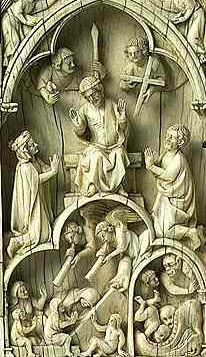Some Western Deëses follow the Orthodox pattern, for example the second picture at right. But most present the scene in the context of the Last Judgment, as in this sculpture. Mary and John are most often kneeling rather than standing, and Last Judgment iconography will include the angels blowing their horns and the dead rising from their graves, as in the third picture at right.
Deëses of this type will also include angels bearing some of the instruments of the Passion to remind the Lord of his redemption of mankind as in this painting from the 15th century and this relief from the 13th.
Prepared in 2016 by Richard Stracke, Emeritus Professor of English, Augusta University. Revised 2016-10-25, 2017-02-13, 2018-03-18, 2018-09-03, 2020-06-05.
HOME PAGE
Roundels in the façade of San Giorgio dei Greci, Venice. Follow this link for a discussion.
OTHER IMAGES

This 10th-century Byzantine ivory exemplifies the original and most common pattern in the East. Enthroned, Christ holds the book on his knee – in this case closed. Mary and John stand erect beside him with gestures of supplication. John an alb and mantle. (See the description page.)

These Byzantine Deësis medallions, circa 1100, dispense with the throne but keep the book. Though not shown full-length, the supplicants are clearly standing erect. Metropolitan Museum. My photo (license), mouseover for larger image.

Some Western images, such as this detail from a 13th-century fresco in South Tyrol, preserve the Byzantine pattern. Christ is enthroned with his closed book, and the supplicants stand. John wears an alb. (See the description page.)

Produced in the same century as the fresco above, this ivory diptych of the Last Judgment exemplifies the Western take on the Deësis. Christ is enthroned but the book is gone. The supplicants do not stand but kneel. And angels join the entreaty by showing Christ the instruments of the crucifixion. See the description page
MORE IMAGES
- 13th century: Historiated capital at Burgos Cathedral, Spain.
- 13th century: Fragment of a fresco in an apse in Zadar, Croatia.
- 13th century: Apse fresco in a Croatian church.
- Circa 1400: This illumination for the "Seven Requests of Our Lord" prayer in a Book of Hours adapts the Deësis by having the resurrected bodies of Judgment Day join with Mary and John in supplication. The same occurs in a very similar miniature from later in the century.
- 16th century: Painting in a Burgos church: Mary reminds Christ of the breasts that suckled him.
ALSO SEE
